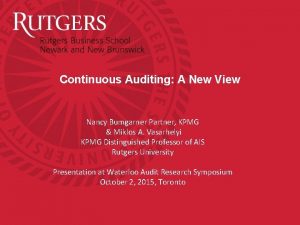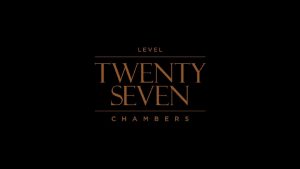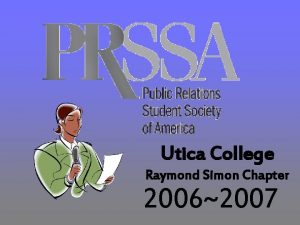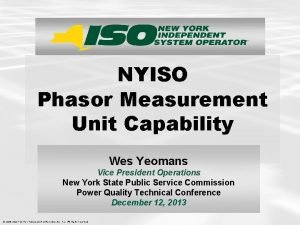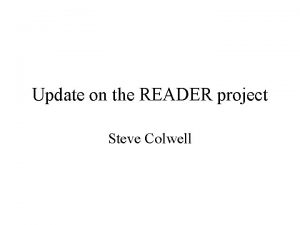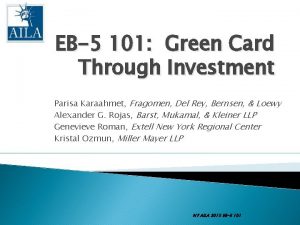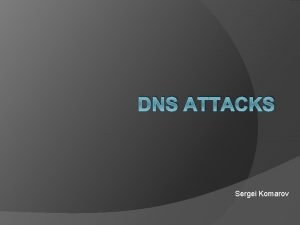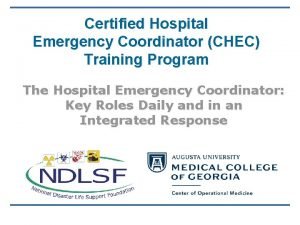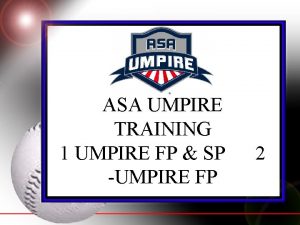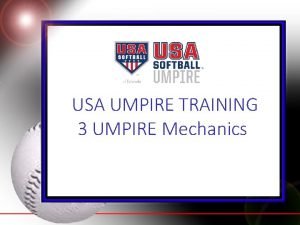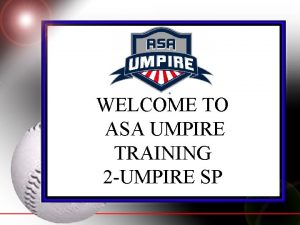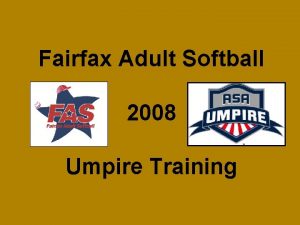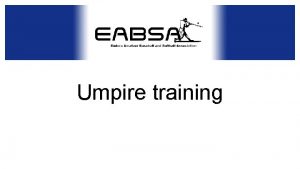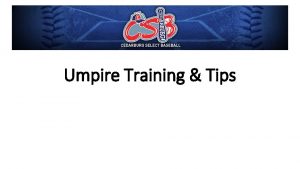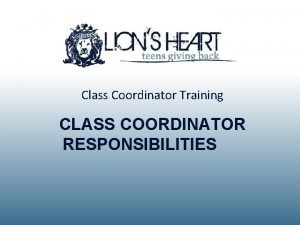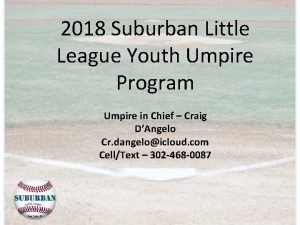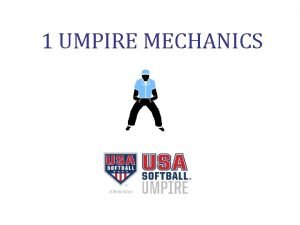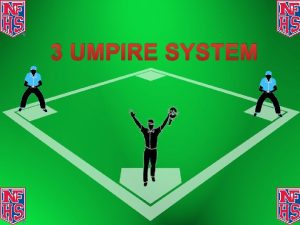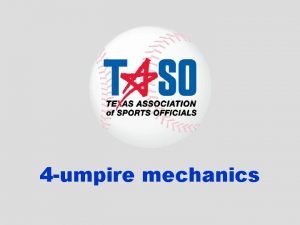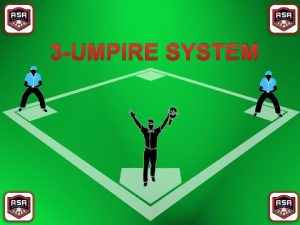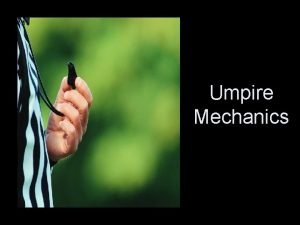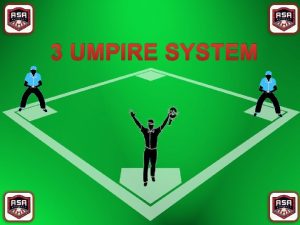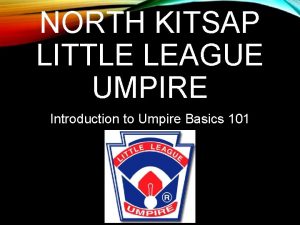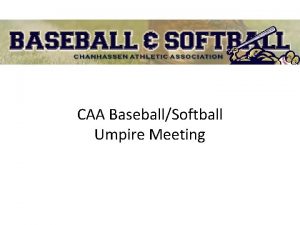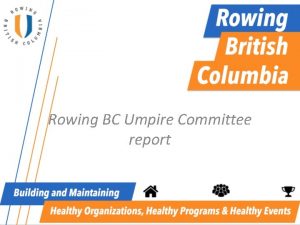MLL Umpire 101 Training Umpire Coordinator Contact Info























- Slides: 23

MLL Umpire 101 Training Umpire Coordinator Contact Info: umpire@monarchll. org

Agenda Pre – Pick up shirt, books + sign-in sheet 900 – Welcome, Intros, discuss agenda and logistics for the day 905 -1010 - Intro to Umpiring 1010 -1040 - Rules and Scenarios 1040 -1045 – Umpire Signup process 1045 -1100 - Q&A discussion and wrap up Post – Pick up shirt, books + sign-in sheet

Little League is a program of service to youth. It is geared to provide an outlet of healthful activity and training under good leadership in the atmosphere of wholesome community participation. The movement is dedicated to helping children become good and decent citizens. It strives to inspire them with a goal and to enrich their lives towards the day when they must take their places in the world. It establishes the values of teamwork, sportsmanship and fair play. Philosophy

Umpiring • Umpire is the only occupation where a person has to be perfect on Opening Day and improve as the season goes on. - Anonymous • The third team on the field at every Little League game • Important for a safe, well officiated game • The more you know the rules, the better the game experience • Opportunity to positively contribute to your player’s Little League experience

Register as volunteer and complete background check MLL Registration Site

Umpire Resources for you today • 2021 Rule. Book - Grab one today or download it online • Little League Rules, Regulations, and Policies • Make the Call Book - Cliff Notes version of the Rule Book – recommend starting with this one • Navy Blue Umpire Shirt • Umpire boxes at the fields have protective gear, clickers, brush, ump gear/ball bag, caps

Lockboxes at Fields Code = contact Board member

Scheduling Umpires for Games Umpire Scheduling Google Sheet

Resources • MLL Umpire Website Link • You. Tube – lots of good training videos

10 Commonly Misinterpreted Little League® Rules

The hands are considered part of the bat. If a pitch hits the batter’s hands it is either fair or foul. Approved Ruling: The hands are part of the batter’s body. Therefore, an umpire must judge if the ball hit the bat or the batter first. This scenario is covered by Little League rule 6. 08(b).

If the batter “breaks his wrists” when swinging, it's a strike. Approved Ruling: The term “breaks his/her wrists” does not appear in the Little League rulebook. The umpire must judge whether, or not, the batter attempted to swing at the pitch as stated in the definition of a strike in Rule 2. 00

If a batted ball hits the plate first it’s a foul ball. Approved Ruling: Home plate, first, second, and third base are all completely within fair territory. The foul lines are also within fair territory. In order to rule the ball foul, it must have come to rest in foul territory or be touched in foul territory. See Rule 2. 00.

The hands are considered part of the bat. If a pitch hits the batter’s hands it is either fair or foul. Approved Ruling: The hands are part of the batter’s body. Therefore, an umpire must judge if the ball hit the bat or the batter first. This scenario is covered by Little League rule 6. 08(b).

The batter cannot be called out for interference if he is in the batter's box. Approved Ruling: Offensive/Batter Interference is defined in Rule 2. 00, and there is no specific exception for the batter’s box. The batter’s actions are what causes interference and not necessarily where he is, as defined in Rule 6. 06(c) (1), (2) and (3).

The ball is dead on a foul-tip. Approved Ruling: As defined in Rule 2. 00, the ball is always live on a foul tip. Therefore runners may be put or advance at their own risk.

The batter may not switch batter's boxes after two strikes. Approved Ruling: The batter may switch batter’s boxes at any time while the ball is dead. According to Rule 6. 06(b), the batter may only be called out for stepping from one batter’s box to the other while the pitcher is in position ready to pitch. The number of balls or strikes on the batter is not relevant.

The batter who batted out of order is the person declared out. Approved Ruling: According to Rule 6. 07, the batter that is supposed to bat (the proper batter) is the one that is declared out, when the defensive properly appeals the infraction.

The batter is considered “out” if he/she starts for the dugout before going to first base after an uncaught third strike. Approved Ruling: In order to declare the batter “out” for abandoning his/her effort to advance, he/she must step into “dead ball” territory.

The batter-runner is always out if he runs outside the running lane after a bunted ball. Approved Ruling: The batter-runner may be called out for interference if he fails to run within the runner’s lane for the last half of the distance to first base. Furthermore, the defensive team must throw the ball in order for the interference to occur Rule 6. 06(j).

If a batter swings at a pitch, and the pitch hits the batter in the batter’s box, the batter is awarded first base. Approved Ruling: The batter is not awarded first base. A strike is defined in Rule 2. 00(e). Since the batter swung, a strike is recorded, and, if it was the third strike, the batter is out. No uncaught strike situation occurred since the ball is dead once it contacts the batter.

The Golden Rule of Baseball Umpiring Rule 9. 02. a – “Any Umpire’s decision which involves judgement, such as, but not limited to, whether a batted ball is fair or foul, whether a pitch is a strike or a ball, or whether a Runner is safe or out, is FINAL. No Player, Manager, Coach or Substitute shall object to any such judgment decisions. Any such objection, if voiced by any of these parties, is grounds for immediate ejection from the game.

Q&A/Discussion
 Nancy bumgarner contact info
Nancy bumgarner contact info Neeraj pai contact info
Neeraj pai contact info Ryan kuenzi contact info
Ryan kuenzi contact info Pam nicholson net worth
Pam nicholson net worth Ondrej dusek contact info
Ondrej dusek contact info Peter brundage
Peter brundage Rick strohmaier contact info
Rick strohmaier contact info Shane monks barrister
Shane monks barrister Raymond simon contact info
Raymond simon contact info Wes yeomans contact info
Wes yeomans contact info Ryan witz contact info
Ryan witz contact info Steve colwell contact info
Steve colwell contact info Richard halkett
Richard halkett Steve starzynski contact info
Steve starzynski contact info Paul pousson contact info
Paul pousson contact info Narendra acharya contact info
Narendra acharya contact info Comminuated
Comminuated Parisa karaahmet contact info
Parisa karaahmet contact info Sergei komarov contact info
Sergei komarov contact info Omar chane contact info
Omar chane contact info Paul sheward contact info
Paul sheward contact info Paul monus contact info
Paul monus contact info Chec hospital
Chec hospital Spice portal schneider
Spice portal schneider
